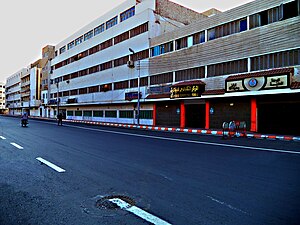Caene
|
Qena قنا Kena |
|
|---|---|
 |
|
| Location in Egypt | |
| Coordinates: 26°10′12″N 32°43′38″E / 26.17000°N 32.72722°E | |
| Country | Egypt |
| Governorate | Qena |
| Elevation | 75 m (246 ft) |
| Population (2012) | |
| • Total | 230,392 |
| Time zone | EET (UTC+2) |
| Area code(s) | (+20) 96 |
Qena (Arabic: قنا Qinā , Egyptian Arabic: [ˈʔenæ], locally: [ˈɡena]) is a city in Upper Egypt, and the capital of the Qena Governorate. Situated on the east bank of the Nile, it was known in antiquity as Kaine (Greek Καινή, meaning "new (city)"; Latinized transliteration: Caene) and Maximianopolis.
This provincial capital is located about 57 miles from El Balyana and 39 miles north of Luxor. It is most famous for its proximity to the ruins of Dendara. It owes its modern prosperity to the opening of the Wadi Qena towards the Red Sea, which is a major traffic route between Upper Egypt and the Red Sea. Tourists traveling between Luxor and the Red Sea will assuredly pass through this city since there is only one good road connection. Qena is noted for its pottery, in particular the porous water.
In addition to its Ancient Egyptian heritage as the city of Cainepolis. Qena has a considerable Islamic heritage and a famous mosque. The Maghrebi Abd el-Rahim settled in Qena upon his return from Mecca and founded a Sufi center here. Upon his death in 1195, the mosque was built above his tomb and became a place of pilgrimage. There is a huge modern mosque of Sheikh el-Qenawi in the main square which attests to his importance.
Qena has witnessed major restorations, and came third in the UNESCO City Beauty contest.
...
Wikipedia

